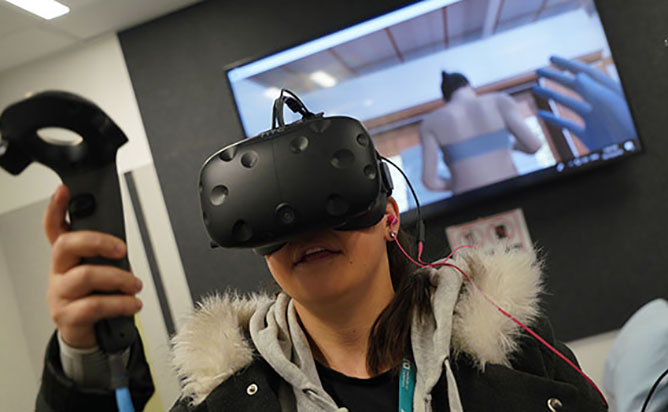VR Delivers New Teaching Era at Ara
01 November, 2019
Ara’s midwifery and nursing students are getting a new way of gaining hands on experience in 2020. A virtual reality (VR) birthing scenario, that aims to improve students’ skills before they head into the real world, is being rolled out at Ara early next year.
This VR programme was developed in conjunction with Ara and Virtual Medical Coaching. Company founder James Hayes says it has been over a year in the making.
“I was a medical imaging lecturer at Ara and we had this idea that we could do a lot of the simulation in VR. We had been using VR successfully in teaching medical imaging for a few years and when we were asked if we could do this for midwifery the answer was yes. We then tried to work out how to do it. We relied on all the content knowledge from the midwifery staff at Ara and with the help from our development team we integrated it into our platform to develop the first VR birthing scenario ever for Ara, which the nurses and midwifery students will be using.”
The full scenario takes place in a primary birthing unit in which a woman called Zara has arrived in advanced labour. Her partner Philip is also in the room and the student operating the VR can call another midwife in to assist and oversee the birth. The student makes decisions based on observations, basic examinations, listening to the foetal heartbeat and questioning the woman.
Using VR the student learns in a safe environment how to support the woman to birth her baby safely. After the birth the placenta is examined, followed with the after care of the baby including taking the baby’s APGAR scores and assisting the woman with the start of breast feeding in accordance with the World Health Organisation’s codes for breastfeeding.
One of Ara’s midwifery tutors, Melanie Welfare, says the VR scenario is an excellent way for students to practice their skills and decision-making while being in a situation that is really safe and supportive. It is an environment where they are not putting themselves, the woman or the baby at any risk.
“Some of the students starting in midwifery and nursing have never witnessed a birth. To be able to use VR and start to become acclimatised to what a birth situation looks like is really helpful for them. The VR scenario provides a gentle way to be part of a process in a non-confronting manner and to see how a birth unfolds.”
“We also want to integrate the VR programme into second and third year. We are planning to add on the additional skills students need to learn. For example, in the second year we are starting to work with more complex births, so we are developing ways to integrate critical situations into the scenario. There are a few ways how we can expand and grow this from a midwifery perspective.”

Midwifery student Kiri Pitman is trialing the VR birthing scenario with tutor Melanie Welfare supervising.
VR is becoming a great tool in tertiary education to enhance students’ learning experience says Hayes.
“The costs of a virtual reality set up have gone down a lot over the years and it’s as affordable as a few textbooks these days.”
He is planning to expand the birthing scenario by adding more data analysis in the background and student self-assessment options. According to Hayes, artificial intelligence and machine learning could also lead to more than one level of difficulty that the students get exposed to, depending on their previously learnt skills.
Welfare said she would like to use this virtual birth scenario as a basis for some research into how spatial computing can be further included into health students’ learning experience.
“I also want to look at the wider community and how we could get them to use our VR scenario. For example, when teaching parenting education or exploring how St John could use this VR set up as a way of training some of the ambulance staff and paramedics as well as if it would be useful for the military before they go to somewhere like East Timor.”